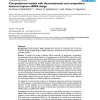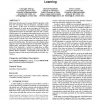5381 search results - page 1047 / 1077 » Artificial neural networks |
110
click to vote
ICML
1996
IEEE
16 years 19 days ago
1996
IEEE
Some of the most successful recent applications of reinforcement learning have used neural networks and the TD algorithm to learn evaluation functions. In this paper, we examine t...
BMCBI
2006
14 years 12 months ago
2006
Background: Small interfering RNAs (siRNAs) have become an important tool in cell and molecular biology. Reliable design of siRNA molecules is essential for the needs of large fun...
ATAL
2009
Springer
15 years 6 months ago
2009
Springer
Multi-Agent Reinforcement Learning (MARL) algorithms suffer from slow convergence and even divergence, especially in largescale systems. In this work, we develop an organization-b...
GECCO
2009
Springer
15 years 6 months ago
2009
Springer
The Session Initiation Protocol (SIP) is the de facto standard for user’s session control in the next generation Voice over Internet Protocol (VoIP) networks based on the IP Mul...
102
click to vote
GECCO
2005
Springer
15 years 5 months ago
2005
Springer
Mapping biology into computation has both a domain specific aspect – biological theory – and a methodological aspect – model development. Computational modelers have implici...


